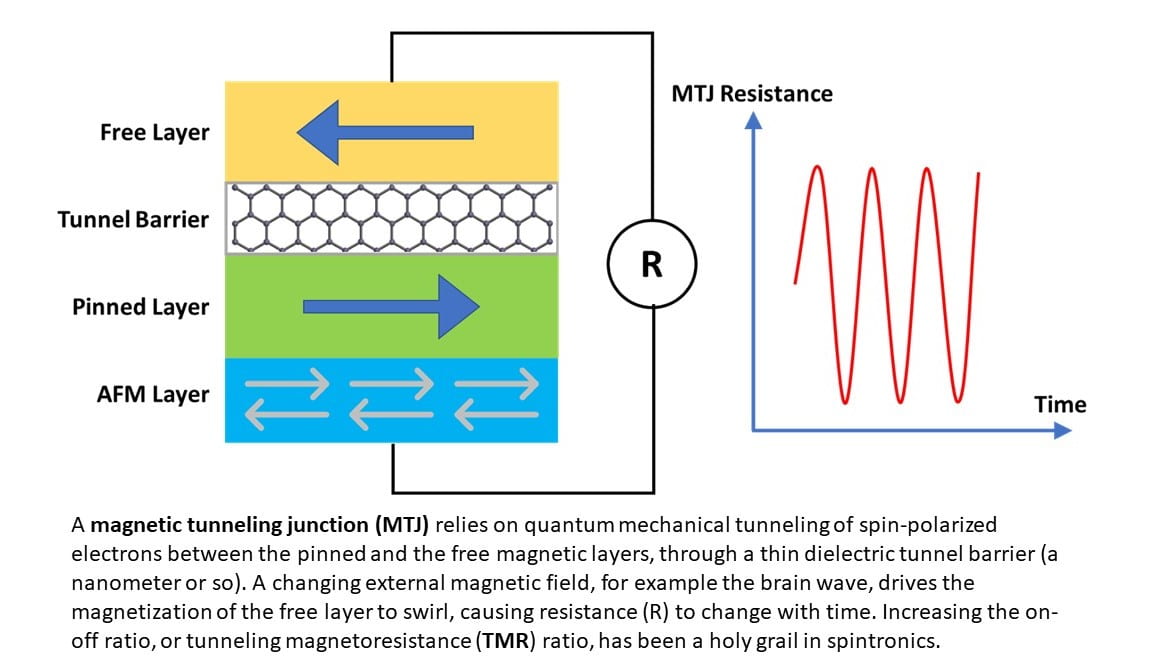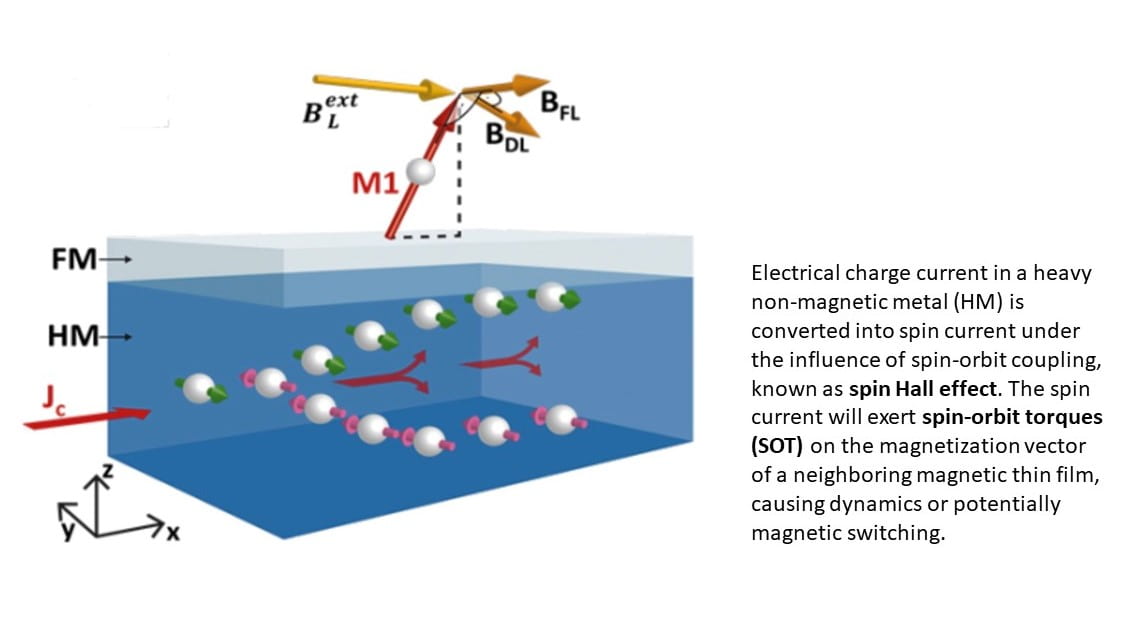Spintronics, also known as magnetoelectronics or spin-based electronics, is a growing field that explores a new type of electronics based on the spin degree of freedom of electrons. Unlike traditional electronics that rely on electron charge, spin-based electronics take advantage of the magnetic moment of electrons that is intimately related to their spin. Spintronic devices are nonvolatile and quantum-mechanical computing based on spintronics could achieve unprecedented computing speeds. The research on spintronics includes the development of spin valves with giant magnetoresistance, magnetic tunneling junctions, and the spin torque effect.
Spin valves use the quantum mechanical behavior of electrons to control the resistance of the device, allowing external magnetic fields to switch it on or off. Magnetic tunneling junctions employ the tunneling magnetoresistance effect, and two ferromagnetic plates separated by a thin insulating layer, to filter the electrons. The spin-transfer torque (STT) effect transfers angular momentum between a magnetized ferromagnetic layer and a current of spin-polarized electrons to control the magnetization of the magnet. On the other hand, the spin-orbit torque (SOT) effect is a phenomenon that involves the transfer of spin angular momentum to or from an electron’s orbital motion in a material with strong spin-orbit coupling. When a current is passed through such a material, the spin-orbit interaction can generate a torque that affects the magnetization of a nearby magnetic layer. This effect is known as spin-orbit torque (SOT), and it has potential applications in magnetic memory and logic devices. Specifically, spin-orbit torque can be used to manipulate the orientation of magnetic domains in a material, which can be used to write and read information in magnetic memory devices. Spintronics could be the future of electronics, enabling the development of smaller, faster, and more efficient devices.
Our research group is dedicated to exploring the full spectrum of spintronics and applying our findings to the development of innovative spintronic devices for computing and sensing.
We thank the National Science Foundation, National Institutes of Health, Brown OVPR and Carney Institute for Brain Science for their support of our research.
Return to Research page.
Recent publications from our group:
Yu Matsushima, Zijing Zhang, Yuri Ohashi, Tsunagu Hatakeyama, Gang Xiao, Takumi Funato, Mamoru Matsuo, Hideo Kaiju “Emergent magneto-inductance effect in permalloy thin films on flexible polycarbonate substrates at room temperature”, Appl. Phys. Lett. 124, 022404 (2024).
Guanyang He, Yiou Zhang and Gang Xiao, “Sensitivity Enhancement and Random Telegraph Noise in Magnetic Tunnel Junctions with Compensated Anisotropy”, Physical Review Applied 19, 024069 (2023).
Kenta Sato, Hiroaki Sukegawa, Kentaro Ogata, Gang Xiao and Hideo Kaiju “Large magnetocapacitance beyond 420% in epitaxial magnetic tunnel junctions with an MgAl2O4 barrier”, Scientific Reports 12:7190 (2022). https://doi.org/10.1038/s41598-022-11545-6.
Kentaro Ogata, Yusuke Nakayama, Gang Xiao, and Hideo Kaiju “Observation and theoretical calculations of voltage-induced large magnetocapacitance beyond 330% in MgO-based magnetic tunnel junctions”, Scientific Reports 11, 13807 (2021). https://doi.org/10.1038/s41598-021-93226-4.
Guanyang He, Yiou Zhang, Yuebin Hu, Xixiang Zhang, and Gang Xiao “Magnetic tunnel junction based gradiometers for detection of cracks in cement”, Sensors and Actuators: A. Physical, 112966 (2021). https://doi.org/10.1016/j.sna.2021.112966.
Kang Wang, Yiou Zhang, Shiyu Zhou, and Gang Xiao “Micron-scale Anomalous Hall Sensors Based on FexPt1-x Thin Films with a Large Hall Angle and near the Spin Reorientation Transition”, Nanomaterials 11, 854 (2021). https://doi.org/10.3390/nano11040854.
Takeru Nakagawa, Kentaro Ogata, Yusuke Nakayama, Gang Xiao, and Hideo Kaiju “Sign Inversion Phenomenon of Voltage-induced Tunnel Magnetocapacitance”, Applied Physics Letters 118, 182403 (2021). https://doi.org/10.1063/5.0050304.
Yuanjun Yang, Zhenlin Luo, Shutong Wang, Wenyu Huang, Guilin Wang, Cangmin Wang, Yingxue Yao, Zhili Wang, Jingtian Zhou, Yongqi Dong, Jinhua Guo, Yong Guan, Yangchao Tian, Ce Feng, Yonggang Zhao, Chen Gao, and Gang Xiao “Electric-field-assisted non-volatile magnetic switching in a magnetoelectronic hybrid structure”, iScience 24, 102734 (2021). https://doi.org/10.1016/j.isci.2021.102734.
Yiou Zhang, Kang Wang, and Gang Xiao “Noise characterization of ultrasensitive Anomalous Hall Effect sensor based on Co40Fe40B20 thin films with compensated in-plane and perpendicular magnetic anisotropies”, Appl. Phys. Lett. 116, 212404 (2020).
Kang Wang, Yiou Zhang, and Gang Xiao “Anomalous Hall Sensors with High Sensitivity and Stability Based on Interlayer Exchange-Coupled Magnetic Thin Films”, Phys. Rev. Appl. 13, 064009 (2020).
Guanyang He, Yiou Zhang, and Gang Xiao “Non-hysteretic Vortex Magnetic Tunnel Junction Sensor with High Dynamic Reserve”, Phys. Rev. Applied 14, 034051 (2020).
Lijuan Qian, Kang Wang, Yi Zheng, and Gang Xiao “Spin Hall effect in α-phase and β-phase TaxW100-x alloys”, Phys. Rev. B 102, 094438 (2020).
T. M. Spicer, C. J. Durrant, P. S. Keatley, V. V. Kruglyak, Wenzhe Chen, Gang Xiao, and R. J. Hicken “Current-induced picosecond magnetization dynamics in a Ta/CoFeB/MgO Hall Bar”, J. Phys. D: Appl. Phys. 52, 355003 (2019).
Yiou Zhang, Guanyang He, Xixiang Zhang, and Gang Xiao “Magnetotransport and electronic noise in superparamagnetic magnetic tunnel junctions”, Appl. Phys. Lett. 115, 022402 (2019).
Yiou Zhang, Qiang Hao, Gang Xiao “Low Frequency Noise of Magnetic Sensors based on Anomalous Hall Effect in Fe-Pt Alloys”, Sensors 19, 3537 (2019).
Yiou Zhang and Gang Xiao “Spin-dependent shot noise in MgO-based magnetic tunnel junctions under noncollinear magnetization alignments”, Phys. Rev. B 100, 224402 (2019).
Qiang Hao, Wenzhe Chen, Shutong Wang, and Gang Xiao “Anomalous Hall effect and magnetic properties of FexPt100-x alloys with strong spin-orbit interaction”, J. Appl. Phys. 122, 033901 (2017).
Wenzhe Chen, Lijuan Qian, and Gang Xiao “A β-Ta system for current induced magnetic switching in the absence of external magnetic field”, AIP Advances, 8, 055918 (2018).
Y. Yang, Y. Yao, L. Chen, H. Huang, B. Zhang, H. Lin, Z. Luo, C. Gao, Y.L. Lu, X. Li, and Gang Xiao, C. Feng, and Y.G. Zhao “Controlling the anomalous Hall effect by electric-field-induced piezo-strain in Fe40Pt60/(001)-Pb(Mg1/3Nb2/3)0.67Ti0.33O3 heterostructures”, Appl. Phys. Lett. 112, 033506 (2018).
Wenzhe Chen, Lijuan Qian, and Gang Xiao “Deterministic current induced magnetic switching without external field using giant spin Hall effect of β-W”, Scientific Reports 8, 8144 (2018).
Hideo Kaiju, Takahiro Misawa, Taro Nagahama, Takashi Komine, Osamu Kitakami, Masaya Fujioka, Junji Nishii, and Gang Xiao “Robustness of non-equilibrium magnetocapacitance in magnetic tunnel junctions”, Scientific Reports 8, 14709 (2018).
Wenzhe Chen, Gang Xiao, Qiang Zhang, and Xixiang Zhang “Temperature study of the giant spin Hall effect in the bulk limit of β-W”, Phys. Rev. B 98, 134411 (2018).
Lijuan Qian, Wenzhe Chen, Kang Wang, Gang Xiao “Spin Hall effect and current induced magnetic switching in antiferromagnetic IrMn”, AIP Advances 8, 115323 (2018).
Guanyang He, Yiou Zhang, Lijuan Qian, Gang Xiao, Qiang Zhang, Carlos Santamarina, Patzek Tadeusz, and Xixiang Zhang “PicoTesla magnetic tunneling junction sensors integrated with double staged magnetic flux concentrators”, Appl. Phys. Lett. 113, 242401 (2018).
Hideo Kaiju, Taro Nagahama, Shun Sasaki, Toshihiro Shimada, Osamu Kitakami, Takahiro Misawa, Masaya Fujioka, Junji Nishii, and Gang Xiao, “Inverse tunnel magnetocapacitance in Fe/Al-oxide/Fe3O4”, Scientific Reports 7, 2682 (2017).
Qiang Hao, Wenzhe Chen, Shutong Wang, and Gang Xiao “Anomalous Hall effect and magnetic properties of FexPt100-x alloys with strong spin-orbit interaction”, J. Appl. Phys. 122, 033901 (2017).
C.J. Durrant, R.J. Hicken, Qiang Hao, and Gang Xiao and “Scanning Kerr microscopy of current induced switching in Ta/CoFeB/MgO films with perpendicular magnetic anisotropy”, Phys. Rev. B 93, 014414 (2016).
Qiang Hao, Cameron Reid, Gang Xiao, and Hon Ming Chan “Magnetic stability under magnetic cycling of MgO-based magnetic tunneling junctions with an exchange-biased synthetic antiferromagnetic pinned layer”, AIP Advances 6, 025303 (2016).
Qiang Hao and Gang Xiao “Giant spin Hall effect and switching induced by spin transfer torque in a W/CoFeB/MgO structure with perpendicular magnetic anisotropy”, Phys. Rev. Applied 3, 034009 (2015).
Qiang Hao, Wenzhe Chen, and Gang Xiao “Beta (β) tungsten thin films: structure, electron transport, and giant spin Hall effect”, Appl. Phys. Lett. 106, 182403 (2015).
Qiang Hao and Gang Xiao “Giant spin Hall effect and magnetotransport in a Ta/CoFeB/MgO layered structure: a temperature dependence study”, Phys. Rev. B. 91, 224413 (2015).
Hideo Kaiju, Masashi Takei, Takahiro Misawa, Taro Nagahama, Junji Nishii, and Gang Xiao “Large magnetocapacitance effect in magnetic tunnel junctions based on Debye-Fröhlich model”, Appl. Phys. Lett. 107, 132405 (2015).

